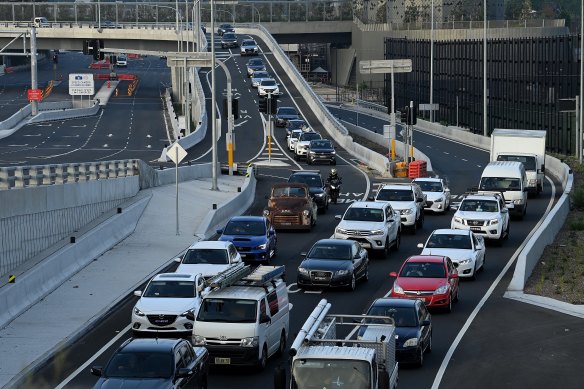States will have to prove big builds worth it before Albanese government chips in
By David Crowe
A national funding deal will toughen the rules on road and rail spending worth $125 billion after the federal government said Victoria would have to prove the economic case for its controversial Suburban Rail Loop.
The new terms will put more onus on the states to prove the business case for mammoth construction, while the federal government also wants them to fund an equal share of regional road spending to create more incentives to keep costs down.
Federal Infrastructure Minister Catherine King said the changes would demand better planning from the states before federal money was paid, declaring the new terms “can and must” prevent delays and cost blowouts.

Infrastructure Minister Catherine King says issues with Sydney’s Rozelle Interchange could be examined to ensure they were not repeated.Credit: Kate Geraghty
Days after the opening of Sydney’s new Metro, King pointed to it and Melbourne’s Metro as leading examples of the way rail lines could support thousands of new homes around major transport hubs – and therefore justify federal funding.
But she admitted there were lessons from the outcry over traffic congestion at the Rozelle Interchange in Sydney’s inner west, suggesting national agency Infrastructure Australia could examine the failures to ensure they were not repeated.
“The fact that you can say that it had the struggle that it had, I think that is a lesson,” King said of the interchange on the WestConnex motorway.
“One of the things that we have not done well, and we’ve got Infrastructure Australia to do, is to go back and look at projects and do a snapshot evaluation, so we are constantly improving the investment decisions that are being made in infrastructure.
“They are independent of me and they will choose which ones they look at.”
King said she “absolutely” backed NSW Premier Chris Minns in wanting large housing developments around transport hubs to ease the housing crisis, and she pointed to the Metro lines in Sydney and Melbourne, as well as the Cross River Rail project in Brisbane, as examples.
“They are big projects, and they do have significant economic benefits and social benefits because it isn’t just about rail,” she said.
“It’s actually about creating new centres of economic activity, new centres for housing.
“And we know with our housing targets, we’ve got to build houses around existing public transport and new public transport to make sure we can get people into workplaces or develop new economic places for that to happen. And rail offers that like no other infrastructure project does.”
But King sent a warning signal about the multibillion-dollar Suburban Rail Loop planned for Melbourne by making it clear the Victorian government would have to convince Infrastructure Australia about the economic case for significant spending.
“Rail is always very challenging because it is incredibly expensive – it’s the most expensive infrastructure that we build,” she said.
“You’ve got to be able to demonstrate that you’re shifting people from cars to rail.
“But it’s really important in these projects to get that discipline, to be able to show that you are bringing the economic benefits.”
Federal Labor promised $2.2 billion to the Suburban Rail Loop upon coming to power but is yet to commit anything further to the project, which is estimated to cost $35 billion in its first phase.
King said the federal money was yet to be paid and emphasised the need to prove the rail project would add to economic growth.
The national agreement does not specify individual projects and instead governs all land transport with a funding plan that imposes new tests for project planning and risk management.
The terms have been put to all states and already signed by Queensland, South Australia and the ACT, with the same deal being put to NSW, Victoria, Western Australia, Tasmania and the Northern Territory.
The document does not specify the funding split for regional road projects, but King wants the states and territories to pay half the cost of new roads, replacing an old approach that expected Canberra to pay 80 per cent of the cost.
King said this would not lead to a cut in federal spending on regional roads because the objective was to put more onus on the states to avoid cost blowouts, given their budgets would have to carry an equal share of the burden.
On the Bruce Highway in Queensland, she said, the federal government would keep spending over time but would expect the state government to match the 50:50 split.
“There’s actually now more money in the pipeline than when we came into office,” she said.
“So it’s not a huge amount more, but it’s sitting at about $125 billion when it sat at $120 billion before. What this means is lifting the state’s share. So, for example, on things like the Bruce Highway, you know, our contribution will remain the same. What we’re asking is that the states do the lifting as well and share the risks.”
Cut through the noise of federal politics with news, views and expert analysis. Subscribers can sign up to our weekly Inside Politics newsletter.